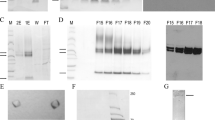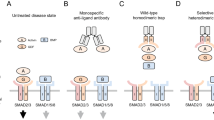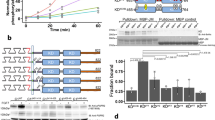Abstract
Transforming growth factor-β (TGF-β) is the prototype of a large family of structurally related cytokines that play key roles in maintaining cellular homeostasis by signaling through two classes of functionally distinct Ser/Thr kinase receptors, designated as type I and type II. TGF-β initiates receptor assembly by binding with high affinity to the type II receptor. Here, we present the 2.15 Å crystal structure of the extracellular ligand-binding domain of the human TGF-β type II receptor (ecTβR2) in complex with human TGF-β3. ecTβR2 interacts with homodimeric TGF-β3 by binding identical finger segments at opposite ends of the growth factor. Relative to the canonical 'closed' conformation previously observed in ligand structures across the superfamily, ecTβR2-bound TGF-β3 shows an altered arrangement of its monomeric subunits, designated the 'open' conformation. The mode of TGF-β3 binding shown by ecTβR2 is compatible with both ligand conformations. This, in addition to the predicted mode for TGF-β binding to the type I receptor ectodomain (ecTβR1), suggests an assembly mechanism in which ecTβR1 and ecTβR2 bind at adjacent positions on the ligand surface and directly contact each other via protein–protein interactions.
This is a preview of subscription content, access via your institution
Access options
Subscribe to this journal
Receive 12 print issues and online access
$189.00 per year
only $15.75 per issue
Buy this article
- Purchase on Springer Link
- Instant access to full article PDF
Prices may be subject to local taxes which are calculated during checkout




Similar content being viewed by others
Accession codes
References
Schlunegger, M.P. & Grütter, M.G. J. Mol. Biol. 231, 445–458. (1993).
Daopin, S., Li, M. & Davies, D.R. Proteins Struct. Func. Genet. 17, 176–192 (1993).
Hinck, A.P. et al. Biochemistry 35, 8517–8534 (1996).
Mittl, P.R.E. et al. Protein Sci. 5, 1261–1271 (1996).
Scheufler, C., Sebald, W. & Hulsmeyer, M. J. Mol. Biol. 287, 103–115 (1999).
Griffith, D.L., Keck, P.C., Sampath, T.K., Rueger, D.C. & Carlson, W.D. Proc. Natl. Acad. Sci. USA 93, 878–883 (1996).
Roberts, A.B. & Sporn, M.B. In Peptide growth factors and their receptors (eds Roberts, A.B. & Sporn, M.B.) 421–472 (Springer-Verlag, Heidelberg; 1990).
Wrana, J.L., Attisano, L., Wiesner, R., Ventura, F. & Massagué, J. Nature 370, 341–347 (1994).
Massague, J. Annu. Rev. Biochem. 67, 753–791 (1998).
Daopin, S., Piez, K.A., Ogawa, Y. & Davies, D.R. Science 257, 369–374 (1992).
Schlunegger, M.P. & Grütter, M.G. Nature 358, 430–434 (1992).
Eigenbrot, C. & Gerber, N. Nature Struct. Biol. 4, 435–438. (1997).
Greenwald, J., Fischer, W.H., Vale, W.W. & Choe, S. Nature Struct. Biol. 6, 18–22 (1999).
Kirsch, T., Sebald, W. & Dreyer, M.K. Nature Struct. Biol. 7, 492–496 (2000).
Gray, P.C. et al. J. Biol. Chem. 275, 3206–3212 (2000).
Pellaud, J., Schote, U., Arvinte, T. & Seelig, J. J. Biol. Chem. 274, 7699–7704 (1999).
Bocharov, E.V. et al. J. Biomol. NMR 16, 179–180 (2000).
Burmester, J.K. et al. Proc. Natl. Acad. Sci. USA 90, 8628–8632 (1993).
Qian, S.W. et al. J. Biol. Chem. 271, 30656–30662 (1996).
Burmester, J.K. et al. Growth Factors 15, 231–242 (1998).
Kirsch, T., Nickel, J. & Sebald, W. EMBO J. 19, 3314–3324 (2000).
Feng, X.-H. & Derynck, R. J. Biol. Chem. 271, 13123–13129 (1996).
Zhu, H.J. & Sizeland, A.M. J. Biol. Chem. 274, 29220–29227 (1999).
Weis-Garcia, F. & Massagué, J. EMBO J. 15, 276–289 (1996).
de Vos, A.M., Ultsch, M. & Kossiakoff, A.A. Science 255, 306–312 (1992).
Somers, W., Ultsch, M., De Vos, A.M. & Kossiakoff, A.A. Nature 372, 478–481 (1994).
Rosenweig, B.L. et al. Proc. Natl. Acad. Sci. USA 92, 7632–7636 (1995).
Nohno, T. et al. J. Biol. Chem. 270, 22522–22526 (1995).
Hinck, A.P., et al. J. Biomol. NMR 18, 369–370 (2000).
Cerletti, N. Process for the production of biologically active dimeric protein. U.S. Patent 6,057,430 (2000).
Otwinowski, Z. & Minor, W. Methods Enzymol. 276, 307–326 (1997).
Terwilliger, T.C. & Berendzen, J. Acta Crystallogr. D 55, 849–861 (1999).
Bailey, S. Acta Crystallogr. D 50, 760–763 (1994).
Jones, T.A., Zou, J.-Y., Cowan, S.W. & Kjeldgaard, M. Acta Crystallogr. A 47, 110–119 (1991).
Brünger, A.T. X-PLOR manual version 3.1: A system for X-RAY crystallography and NMR (Yale University, New Haven; 1992).
Brunger, A.T. et al. Acta Crystallogr. D 54, 905–921 (1998).
Cohen, G.H. J. Appl. Crystallogr. 30, 1160–1161 (1997).
Kraulis, P.J. J. Appl. Crystallogr. 24, 946–950 (1991).
Esnouf, R.M. Acta Crystallogr. D 55, 938–940 (1999).
Persistance of Vision Ray Tracer v3.02 http://www.povray.org (1997).
Nicholls, A., Sharp, K.A. & Honig, B. Proteins Struct. Func. Genet. 11, 281–296 (1991).
Kabsch, W. & Sander, C. Biopolymers 22, 2577–2637 (1983).
Wuytens, G. et al. J. Biol. Chem. 274, 9821–9827 (1999).
Read, R.J. Acta Crystallogr. A 42, 140–149 (1986).
Acknowledgements
We thank L. Flaks and J. Berendzen at beamline X8-C at the NSLS, Brookhaven National Laboratory; Z. Dauter and D. Cascio for valuable discussions; OSI Pharmaceuticals for providing E. coli recombinant TGF-β3; and past and present colleagues who commented on the manuscript. This work was supported by an NIGMS grant to A.P.H. and Robert A. Welch Foundation grants to A.P.H. and P.J.H.
Author information
Authors and Affiliations
Corresponding author
Ethics declarations
Competing interests
The authors declare no competing financial interests.
Rights and permissions
About this article
Cite this article
Hart, P., Deep, S., Taylor, A. et al. Crystal structure of the human TβR2 ectodomain–TGF-β3 complex. Nat Struct Mol Biol 9, 203–208 (2002). https://doi.org/10.1038/nsb766
Received:
Accepted:
Published:
Issue Date:
DOI: https://doi.org/10.1038/nsb766
This article is cited by
-
Modeling and fitting protein-protein complexes to predict change of binding energy
Scientific Reports (2016)
-
Crystal structure analysis reveals a spring-loaded latch as molecular mechanism for GDF-5–type I receptor specificity
The EMBO Journal (2009)
-
The structure of myostatin:follistatin 288: insights into receptor utilization and heparin binding
The EMBO Journal (2009)



